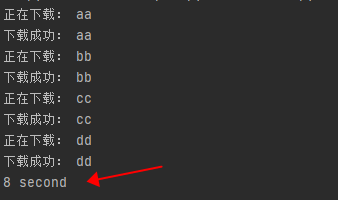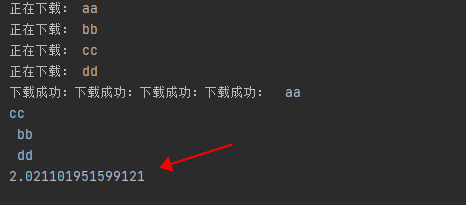- 多线程,多进程(不建议使用)
优点:可以为相关阻塞的操作单独开启线程或者进程,阻塞操作可以异步执行
弊端:无法无限制开启多线程或多进程。 - 原则:线程池处理的是阻塞且耗时的操作
单线爬虫示例
import time
def get_page(str): print("正在下载:",str) time.sleep(2) print('下载成功:',str)
name_list = ['aa','bb','cc','dd']
start_time = time.time()
for i in range(len(name_list)): get_page(name_list[i]) end_time = time.time() print('%d second'% (end_time–start_time))

多线程爬虫示例
import time # 导入线程池模块对应的类 from multiprocessing.dummy import Pool
start_time = time.time() def get_page(str): print("正在下载:",str) time.sleep(2) print('下载成功:',str)
name_list = ['aa','bb','cc','dd']
# 实例化一个线程池对象 pool = Pool(4) # 将列表中每一个列表元素传递给get_page进行处理 pool.map(get_page,name_list)
end_time = time.time() print(end_time–start_time)

案例
# 多线爬虫示例 import requests from lxml import etree import re from multiprocessing.dummy import Pool
headers = { 'User-agent': 'Mozilla/5.0 (Windows NT 10.0; Win64; x64; rv:80.0) Gecko/20100101 Firefox/80.0', 'Content-type':'application/json', } # 对下述url发起请求解析出视频详情页的url和视频的名称 url = "https://pearvideo.com/category_5" page_text = requests.get(url=url,headers=headers).text tree = etree.HTML(page_text) li_list = tree.xpath('//ul[@id="listvideoListUl"]/li') urls = [] #存储所有视频的链接 for li in li_list: detail_url = 'https://pearvideo.com/' + li.xpath('./div/a/@href')[0] name = li.xpath('./div/a/div[2]/text()')[0]+'.mp4' # 对详情页的url发起请求 detail_page_text = requests.get(url=detail_url,headers=headers).text # print(detail_url,name) # 从详情页中解析出视频的地址(url) id = re.findall(r'\d+', detail_url)[0] # https://pearvideo.com/videoStatus.jsp?contId=1751458&mrd=0.32392817067398805 detail_vedio_url = 'https://pearvideo.com/videoStatus.jsp?contId='+id
header1s = { 'User-agent': 'Mozilla/5.0 (Windows NT 10.0; Win64; x64; rv:80.0) Gecko/20100101 Firefox/80.0', 'Content-type': 'application/json', 'referer':detail_url } vedio_text = requests.get(url=detail_vedio_url,headers=header1s).json() # print(vedio_text) vedio_url = vedio_text['videoInfo']['videos']['srcUrl'] dic = { 'name': name, 'url': vedio_url } urls.append(dic) print(vedio_url) def get_video_data(dic): url = dic['url'] print(dic['name'],'正在下载……') data = requests.get(url=url,headers=header1s).content # 持久化存储操作 with open(dic['name'],'wb') as fp: fp.write(data) print(dic['name'],'下载成功') # 使用线程池对视频数据进行请求(较为耗时的阻塞操作) pool = Pool(4) pool.map(get_video_data,urls)
pool.close() pool.join()
神龙|纯净稳定代理IP免费测试>>>>>>>>天启|企业级代理IP免费测试>>>>>>>>IPIPGO|全球住宅代理IP免费测试





